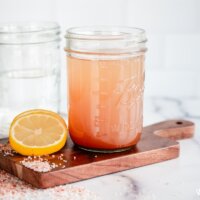In our modern American diet, we’re told that salt is bad and we should avoid it at all costs. But the truth is it’s not the villain it’s often made out to be! It turns out that it’s actually very beneficial to our bodies. There’s some age-old evidence that consuming the right kind of salt daily (unprocessed and unrefined) can be very beneficial for our health. That’s why I love to make sole water!
By increasing salt intake, you provide your body with key electrolytes needed to help it run smoothly. While eating salt is great, sometimes I find it hard to get enough of it on my food without it tasting too salty.
If you want to increase hydration and electrolytes to support your health and wellness, give sole water a try! It’s easy to make and requires just two ingredients.
What is Sole Water?
Sole (pronounced so-lay) is water that’s fully saturated with unrefined salt. Often made with pink Himalayan salt, this concentrated salt water is a great way to increase your electrolytes.
Many people add salt to their water for its health benefits. Sole water isn’t the same as drinking water with salt. It’s water that has fully absorbed the maximum amount of salt (26% actually…. thanks, high school chemistry!). Think of sea water and that’s similar to sole.
While drinking salt in your water is a good practice, sole gives you more electrolytes. We lose electrolytes when we sweat or fast. It’s a great way to replenish these minerals because it provides sodium along with magnesium, calcium, iron, and potassium in trace amounts.
The type of salt you use is key! Regular table salt is overly processed. Manufacturing strips it of many vital minerals. Factories often bleach and add chemicals to the salt to keep it from clumping. You’ll need unprocessed natural salt (Himalayan, Remond, or Celtic sea salt) to make sole.
Why Drink Sole Water?
The health experts have told us for years that salt can be harmful, so drinking salt water may sound counterintuitive. However, multiple studies show drinking seawater (also concentrated salt water) can have a variety of health-supporting benefits. Some countries have used sole for centuries. I drink sole water every day but especially when I’m active (and sweating!) or when I’m fasting.
It’s interesting to note that the conventional recommendation for many of these problems includes removing excess salt from the diet. Table salt can certainly have a negative effect and is best avoided. However, natural salt is less processed and contains trace minerals that aren’t in table salt. Natural salt is incredibly nourishing for the body.
Sole Water Benefits
- Helps Hydration – Our body is made of salt water. During sleep, the body naturally repairs and detoxifies. It uses a good amount of water in the process. Consuming sole first thing in the morning helps the body rehydrate.
- Helps the Body Detoxify – People have used salt for centuries to preserve food. It’s also used as an anti-inflammatory mouth rinse. Because of its antibacterial properties, water made with salt can be useful for the body’s natural detoxification.
- Improves Sleep – Research shows that a diet low in sodium disturbs sleep. Adding sole to your daily routine boosts sodium and other mineral levels that help you sleep.
- Boosts Energy – The minerals in sole help boost energy throughout the day. A 2019 study shows that people who had higher sodium intake had more energy.
- Improves Digestion – A 2020 randomized control group found that drinking salt water stimulates the digestive system. This promotes food absorption and naturally relieves constipation.
- Regulates Heart Rate – Low sodium diets interfere with the heart’s electrical signals, increasing the risk of irregular heartbeat, or arrhythmias.
- Improves Blood Sugar – Research shows that a high-salt diet enhances insulin regulation, while a diet low in salt increases insulin resistance. Some people note improved blood sugar levels after using sole.
- Natural Antihistamine – Salt is a powerful natural antihistamine. This action is likely due to its balancing effects on the body, and I’ve noticed this personally.
- Relieves Muscle Cramps – Since drinking sole regularly and using magnesium, I don’t get leg cramps anymore, even after extreme exercise or during pregnancy. A 2022 review of 8 studies on consuming salt water showed faster recovery after exercise and also improved performance.
- Weight Loss – By improving digestion and nutrient absorption and increasing hydration, sole can help promote weight loss.
Sole is an inexpensive addition to a healthy diet and lifestyle, and it’s incredibly easy to make.
How Do I Make Sole?
As sole is simply salt and water, the quality of the salt is extremely important. While typically made with pink Himalayan salt, you can also use Redmond Salt or Celtic Sea Salt. These unprocessed natural salts all have roughly the same amount of trace minerals, such as magnesium and potassium.
Ayurvedic practices often use Himalayan salt to balance the body’s doshas (energies). You want to make sure to use unprocessed, natural salt.
I like to use mostly Himalayan salt, with a small amount of Redmond Salt or Celtic Salt added. Redmond Salt has the mildest flavored salt of the three, so if you’re new to sole water, that’s an easy one to start with.

Sole Water Recipe
Sole water is saturated with natural salt minerals. It’s great for digestive health, leg cramps, hydration, sleep, and more.
-
Fill the glass jar about ¼ of the way full with Himalayan salt, Celtic sea salt, or Real Salt, or a mixture of the three.
-
Add filtered water to fill the jar, leaving about an inch at the top.
-
Put on the plastic lid and shake the jar gently.
-
Leave on the counter overnight to let the salt dissolve.
-
If there is still some salt on the bottom of the jar the next day, the water has absorbed the maximum amount of salt, and the sole is ready to use.
-
If all of the salt is absorbed, add more salt and continue doing so each day until some remains on the bottom. This means the water is fully saturated with salt.
Nutrition Facts
Sole Water Recipe
Amount Per Serving (1 tsp)
Calories 0
% Daily Value*
Sodium 589mg26%
Potassium 0.1mg0%
Calcium 0.4mg0%
Iron 0.01mg0%
* Percent Daily Values are based on a 2000 calorie diet.
- To use: Mix 1/2 – 1 teaspoon of the sole into a glass of water and drink every morning on an empty stomach. Do not use any metal utensils to measure or stir.
- Salt water is highly corrosive so avoid using metal utensils or a metal lid so it doesn’t oxidize.
How to Use Sole
After making the mixture, store it at room temp. It will last indefinitely as salt is naturally antibacterial and antifungal. Add more water and salt as needed to keep up the amount in the jar. Just watch to make sure there are salt crystals at the bottom of the jar after letting it sit overnight. That means the water has fully absorbed the salt. If there aren’t any extra crystals, add more salt and let it sit overnight again.
To drink, add 1/2 – 1 teaspoon to a glass of water each morning and drink on an empty stomach. Don’t add more, especially when first starting! If this causes a detox reaction or headache, work up slowly. You could also try adding lemon to your water to make it more palatable.
Sole Water Side Effects
When first starting, sole could make you nauseous. If that’s the case, try starting with less. Although it works best when consumed on an empty stomach, you can also add 1/2 – 1 teaspoon to 32 ounces of water and drink it throughout the morning.
Sole can also irritate the stomach or cause diarrhea. If this happens, stop taking it for a few days until your symptoms clear up. If you want to try again, start slowly with a small amount and work your way up.
Who Can Drink Sole?
If you have kidney stones or disease or high blood pressure sole water may not be a good option. Conventional advice says adding more salt to your diet with these conditions could make it worse. However, there is some evidence that says otherwise. If you have these conditions check with your natural healthcare practitioner before consuming sole.
Have you ever made sole water? How did you like it? Share below!
Source:
wellnessmama.com
Source link

